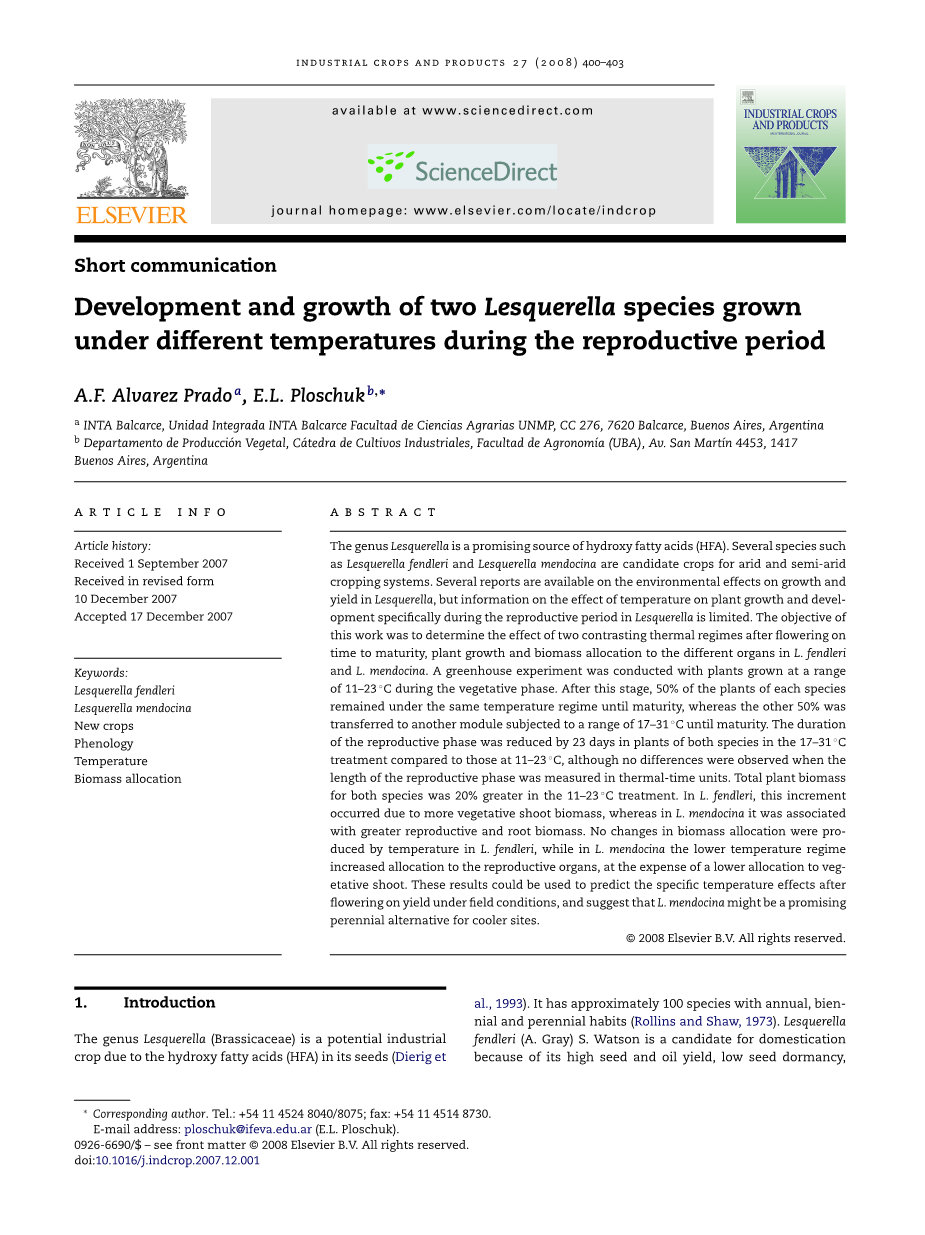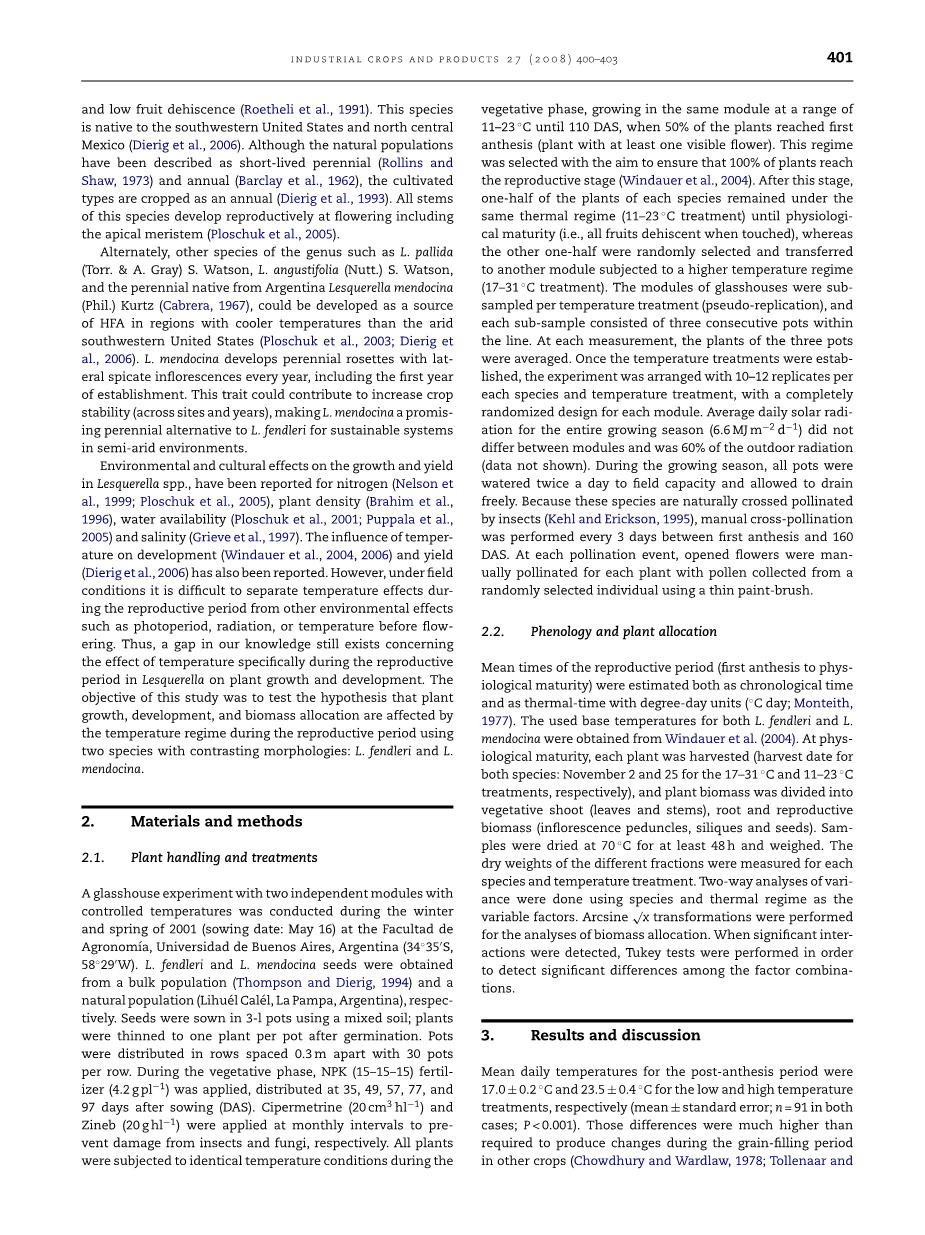

英语原文共 4 页,剩余内容已隐藏,支付完成后下载完整资料
不同的温度下两种lesquerella植物在生殖时期时的生长发育状况论述
F. Alvarez Prado1,E.L. Ploschuk2
- INTA Balcarce, Unidad Integrada INTA Balcarce Facultad de Ciencias Agrarias UNMP, CC 276, 7620 Balcarce, Buenos Aires, Argentina.2.Departamento de Producciorsquo;n Vegetal, Carsquo;tedra de Cultivos Industriales, Facultad de Agronomırsquo;a (UBA), Av. San Martırsquo;n 4453, 1417 Buenos Aires, Argentina)
摘要:lesquerella是羟基脂肪酸的来源,lesquerella的一些种类比如Lesquerella fendleri和Lesquerella mendocina是干旱和半干旱种植制度的候选作物品种,一些关于环境对lesquerella生长和产量影响的报告已经很成熟了,可是温度对植物的生长和发展特别是lesquerella生殖期影响的研究很有限的。这项工作的目的是确定L. fendleri and L. mendocina从开花期到成熟期,两个对比热度对植物的生长和生物量对不同器官的分配的影响。在营养生长期对植物进行了11~12℃的温室实验处理。在这个阶段之后,两个品种50%的植物都保持相同的温度制度直到成熟期,然而另外50%被转移到17~31℃的温度模式下直到成熟期。相比于在11~23℃处理下的植物,在17~31℃下两种植物的生殖期时间都缩短了23天,尽管当以thermal-time units测量生殖期的长短时没有差异被观察到。在11~23℃的处理下两种植物的总生物量增加了20%。对L. fendleri,这个增量是因为有更多的营养枝生物量,然而对于L. mendocina来说这种变化与更大的生殖和根生物量有关。对于L. fendleri没有生物量分配的变化,但是对于 L. mendocina,低温管理使得生殖器官获得更多的分配量,植物的根部对生物量的消耗减少了。这些结果可以用来预测特定的温度对野外条件下开花后产量的影响,并且表明L.mendocina在寒冷的条件下是一种有前景的可替代的多年生植物。
Development and growth of two Lesquerella species grown
under different temperatures during the reproductive period
F. Alvarez Prado1,E.L. Ploschuk2
- INTA Balcarce, Unidad Integrada INTA Balcarce Facultad de Ciencias Agrarias UNMP, CC 276, 7620 Balcarce, Buenos Aires, Argentina.2.Departamento de Producciorsquo;n Vegetal, Carsquo;tedra de Cultivos Industriales, Facultad de Agronomırsquo;a (UBA), Av. San Martırsquo;n 4453, 1417 Buenos Aires, Argentina)
Abstract:The genus Lesquerella is a promising source of hydroxy fatty acids (HFA). Several species such as Lesquerella fendleri and Lesquerella mendocina are candidate crops for arid and semi-arid cropping systems. Several reports are available on the environmental effects on growth and yield in Lesquerella, but information on the effect of temperature on plant growth and development specifically during the reproductive period in Lesquerella is limited. The objective of
this work was to determine the effect of two contrasting thermal regimes after flowering on time to maturity, plant growth and biomass allocation to the different organs in L. Fendleri and L. mendocina. A greenhouse experiment was conducted with plants grown at a range of 11–23 ◦C during the vegetative phase. After this stage, 50% of the plants of each species remained under the same temperature regime until maturity, whereas the other 50% was transferred to another module subjected to a range of 17–31 ◦C until maturity. The duration of the reproductive phase was reduced by 23 days in plants of both species in the 17–31 ◦C treatment compared to those at 11–23 ◦C, although no differences were observed when the length of the reproductive phase was measured in thermal-time units. Total plant biomass for both species was 20% greater in the 11–23 ◦C treatment. In L. fendleri, this increment occurred due to more vegetative shoot biomass, whereas in L. mendocina it was associated with greater reproductive and root biomass. No changes in biomass allocation were produced by temperature in L. fendleri, while in L. mendocina the lower temperature regime increased allocation to the reproductive organs, at the expense of a lower allocation to vegetative shoot. These results could be used to predict the specific temperature effects after flowering on yield under field conditions, and suggest that L. mendocina might be a promising
perennial alternative for cooler sites.
1.引言
由于种子种的羟基脂肪酸(HFA),Lesquerella是一种潜在的工业作物,(Dierig等等。,1993),它有大约100种,一年生,两年生和常年生的(罗林斯和肖,1973)。Lesquerella fendleri (A. Gray) S. Watson是种植的候选物种,因为它的种子和油量产量高,种子休眠短,和较低的水果裂开情况(Roetheliet等,1991)。这个物种原产于美国西南部和墨西哥北部(Dierig 等 .,2006)。尽管自然种群已经被描述为短的多年生植物(罗林斯和肖,1973)和一年生植物(Barclay等., 1962),培养类型被用作一年生植物种植(Dierig 等,1993)。在开花期以及顶端分生组织生长期,这个物种的所有茎都在生长(Ploschuket等, 2005)。
此外,这个物种的其他品种例如L. pallida(Torr. amp; A. Gray) S. Watson, L. angustifolia (Nutt.) S. Watson,和阿根廷本土的常年生作物 Lesquerella mendocina(Phil.) Kurtz (Cabrera, 1967), 可以培育为生长在比干旱的美洲西南部更寒冷的地区的HFA的来源(Ploschuk等, 2003; Dierig 等, 2006)。L.Mendocina生长的研究中利用每一年植株生莲座状穗状花序横向发展,培育出新的品种。这种特征可能有助于提高作物的稳定性(跨站点和年限),使L.Mendocina这种重要多年生植物替代L. Fendleri生活于半干旱环境,并且可持续发展。在雷斯菌生长和产量的环境和文化的影响下,已报道出了氮(Nelson等人,1999年;ploschuk等人,2005年)、种植密度(Brahim等人,1996年)、水的可用性(ploschuk等人,2001年;puppala等人,2005年)和盐度(Grieve等人,1997)。
同时对于温度变化对未来的影响(windauer等人,2004-2006年)及产量(Dierig等人,2006)也有相关报道。然而,在野外条件下很难避免温度的影响,同时植物在生殖期会受到其他环境的影响,如光照、温度辐射,在流量工程之前也会出现相应的影响。因此,我们的知识差距仍然存在,对于Lesquerella的研究尤其应该在植物的生长和发育生殖期间考虑温度的影响。本研究的目的是测试假设,对于L. Fendleri和L.Mendocina植物的生长、发育和生物量的分配中使用两种对比形态,研究其生殖生长期间的温度影响。
2.材料和方法
2.1 植物的处理方法
2001年的冬季到2002年的春季,在Facultad de Agronomacute;ıa, Universidad de Buenos Aires, Argentina 设置了一个独立的模块和控制温度的温室试验。L. Fendleri和L.Mendocina的种子分别从种类很多的种群(Thompson and Dierig等,1994年)和另一个自然生长的种群获得。种子播种用混合土盆栽植物被减少到每盆3-1颗。盆分布的行间距为0.3米,每行30个。在营养生长阶段,氮磷钾肥(4.2 g plminus;1)的使用,分别分布播种后的35,49,57,77和97天。cipermetrine(20 cm3 hlminus;1)和Zineb(20g·hl-1)应该每月喷洒一次,应用于预防伤害昆虫和真菌。所有的植物在营养生长阶段,相同的温度条件(11-23℃)下,生长在同一个模块同一范围内的直到播种后的第110时,植物的50%时达到第一期(即至少有一个可见的花卉植物)。这一时期的植物将会被选为研究对象,目的在于保证100%的植物能达到生殖期(windauer等人,2004年)。
在这个阶段里,每个物种选择一半的植物保持原来的温度(即11-23℃处理方法)直到生长成熟(即所有果实开裂时);而另一半被随机转移到另一个模块受到较高的温度环境控制(即17–31℃的处理方法)。每个温室模块都进行子采样和温度处理(伪复制),每个子样本包括三个盆内。三个盆的植物的平均值作为以此测量。一旦建立了温度处理,每一个物种和温度处理就被安排进行10-12个重复实验,每个模块为一个完全随机的设计。日平均太阳辐射在整个生长季节、不同的模块均为60%的室外辐射(数据未显示)。在生长季节,所有的盆被浇了一天两次并允许自由排水。因为这些品种经过昆虫自然杂交授粉(Kehl and Erickson,1995),在播种后的160天每天3次进行人工异花授粉。在每个植物开花授粉时,各个试验单位随机选择一个对人工授粉用花粉进行收集。
2.2 物候与植物配置
生育期的平均时间由时间(第一次开花至生理成熟的时期)和日度单位热时间决定。L. Fendleri和L.Mendocina的温度指标是用windauer等人研究得到的基板温度决定的。植株在生理成熟期收获,其中处理温度为17–31℃℃的植株在11月2日收获;处理温度为11–23℃的植株在11月25日收获。植物生物量包括营养枝(叶和茎)、根和生殖生物量(花序梗、角果和种子)等。样品至少在70℃环境下存放48h,物种和温度处理的不同组分别进行干重测量。结果的双向方差分析,采用物种和热制度的变量因素。反正弦变换分别对生物量分配情况进行分析,当检测到显著相互作用,利用杜克测试以检测所述因子组合中显著差异。
3.结果与讨论
<p
剩余内容已隐藏,支付完成后下载完整资料</p
资料编号:[29480],资料为PDF文档或Word文档,PDF文档可免费转换为Word
以上是毕业论文外文翻译,课题毕业论文、任务书、文献综述、开题报告、程序设计、图纸设计等资料可联系客服协助查找。


